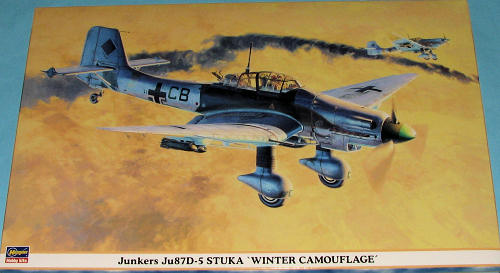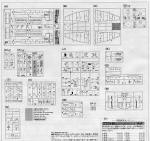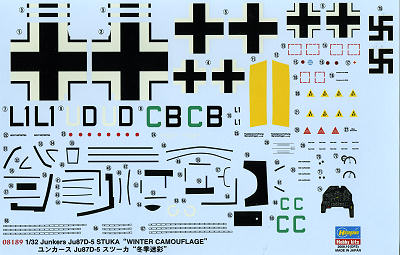
| KIT #: | 08189 |
| PRICE: | $88.99 MSRP |
| DECALS: | options |
| REVIEWER: | Scott Van Aken |
| NOTES: | Limited release of extended wing version |

| HISTORY |
The Junkers Ju 87 or Stuka (from Sturzkampfflugzeug, "dive bomber") was a two-seat (pilot and rear gunner) German ground-attack aircraft of World War II. Designed by Hermann Pohlmann, the Stuka first flew in 1935 and made its combat début in 1936 as part of the Luftwaffe's Condor Legion during the Spanish Civil War.
The aircraft was easily recognizable by its inverted gull wings, fixed spatted undercarriage and its infamous Jericho-Trompete ("Jericho Trumpet") wailing siren, becoming the propaganda symbol of German air power and the Blitzkrieg victories of 1939-1942. The Stuka's design included several innovative features, including automatic pull-up dive brakes under both wings to ensure that the plane recovered from its attack dive even if the pilot blacked out from the high acceleration. Although sturdy, accurate, and very effective, the Ju 87 was vulnerable to modern fighter aircraft, like many other dive-bombers of the war. Its flaws became apparent during the Battle of Britain—poor manoeuvrability, lack of speed and defensive armament meant that the Stuka required a heavy fighter escort to operate effectively.
The Stuka operated with further success after the Battle of Britain, and its potency as a precision ground attack aircraft became valuable to the German war effort in the Balkans Campaign, the African and Mediterranean Theatres and the early stages of the Eastern Front campaigns where Allied fighter resistance was disorganised and in short supply. However, once the Luftwaffe had lost air superiority on all fronts the Ju 87 once again became easy targets for enemy fighter aircraft. In spite of this, and lacking a successor, the type continued to be produced until 1944. By the end of the conflict the Stuka was largely replaced by ground attack versions of the Focke-Wulf Fw 190, but some units, like Sturzkampfgeschwader 2 "Immelmann" operated the Ju 87 to the last day of the war. An estimated 6,500 Ju 87s of all versions were built between 1936 and August 1944. Hans-Ulrich Rudel was the most notable Stuka ace and was the most highly decorated German serviceman of the Second World War. He received the highest German military award, the Ritterkreuz mit Goldenem Eichenlaub, Schwertern und Brillianten, or the Knight's Cross with Oak Leaves, Swords and Diamonds in Gold, on 29 December 1944.
The Ju 87 D-5 (the basis of this kit) was based on the D-3 design and was unique in the Ju 87 series as it had lengthened wings to 0.6 metres longer than previous variants. The powerplant was upgraded to the Jumo 211 P in-line engine with supercharger intercoolers. In August 1943 this was replaced with the Jumo 211 J-1. This engine increased rate of climb by 15 metres per second. With introduction of the Jumo 213 and increased power and climb rate, the lengthened wings were no longer needed. The window in the floor of the cockpit was reinforced and four aileron hinges instead of three were installed. Higher diving speeds were obtained of 650 (408mph) up to 2,000 metres (6,400 feet). Range was recorded as 715km (443 mile) at ground level and 835km (517 miles) at 5,000 metres (16,000 feet). Fuel capacity was in the form of one main 480 litre fuselage tank and two wing tanks of 150 litre capacity. Two 300 litre drop tanks could also be installed under the wings.
| THE KIT |
 Another
in a series of limited release kits with markings appropriate to the box title,
this kit is Hasegawa's fine Ju-87D. This is the D-5 variant. As you'd expect,
there are additional sprues to take into consideration the extended wing tips
and extended ailerons. Also in there are a pair of drop tanks and the wing racks
to hold them. These racks can also have small bombs with the long fuse
extenders. While it would have been nice to have unspatted landing gear as were
often seen when operating in snow or mud, the kit gear is nicely done and having
spatted wheels simplifies doing the landing gear.
Another
in a series of limited release kits with markings appropriate to the box title,
this kit is Hasegawa's fine Ju-87D. This is the D-5 variant. As you'd expect,
there are additional sprues to take into consideration the extended wing tips
and extended ailerons. Also in there are a pair of drop tanks and the wing racks
to hold them. These racks can also have small bombs with the long fuse
extenders. While it would have been nice to have unspatted landing gear as were
often seen when operating in snow or mud, the kit gear is nicely done and having
spatted wheels simplifies doing the landing gear.
Hasegawa's large scale kits seem to include a pilot and this one also has the rear gunner. I'm sure a number of modelers like having this option and these can be used in other, non-Hasegawa kits if one so desires. The wing center section includes a hefty wing spar to help hold on the larger wings and provide alignment. For most of us, the interior is very nicely done and will need little more than careful painting and dry brushing to really look the part. For others, I'm sure there are or will be resin aftermarket bits to meet their needs.
 Markings are for two planes, both of which should first be painted in standard
RLM 70/71/65 prior to applying the winter wash. Hasegawa has thoughtfully
provided paper masks for the rather complex splinter camo to help make it much
easier to do. Both options have small sections of un-winter wash airframe. The
box art plane from SG. 5 in January 1944 has the entire cockpit fuselage area
without the whitewash. The other options is for III./SG1 around the same time
with the back section of the spats and the lower enginecowling in standard
paint. This also has a white forward spinner. Both have yellow undersides to the
wing tips while the second has a yellow fuselage band. This is supplied on the
decal sheet, but will look better if painted the same shade as the under wing
tip area. On both planes, areas around codes or insignia are unpainted with the
winter wash. Decals include the inside framework for the canopy in what is
supposed to be RLM 66, but looks to my eyes to be black. These are 'old school'
markings with whites as an off-white, but with very warm water, should work just
fine.
Markings are for two planes, both of which should first be painted in standard
RLM 70/71/65 prior to applying the winter wash. Hasegawa has thoughtfully
provided paper masks for the rather complex splinter camo to help make it much
easier to do. Both options have small sections of un-winter wash airframe. The
box art plane from SG. 5 in January 1944 has the entire cockpit fuselage area
without the whitewash. The other options is for III./SG1 around the same time
with the back section of the spats and the lower enginecowling in standard
paint. This also has a white forward spinner. Both have yellow undersides to the
wing tips while the second has a yellow fuselage band. This is supplied on the
decal sheet, but will look better if painted the same shade as the under wing
tip area. On both planes, areas around codes or insignia are unpainted with the
winter wash. Decals include the inside framework for the canopy in what is
supposed to be RLM 66, but looks to my eyes to be black. These are 'old school'
markings with whites as an off-white, but with very warm water, should work just
fine.
| CONCLUSIONS |
These really are fine kit and make into superb models when one is finished. They are not so complex and fiddly that they will put off the builder as one finds with some other more recent 1/32 kits. If this aircraft is on your fan favorite list, this would be an excellent choice.
| REFERENCES |
January 2008
My thanks to www.dragonmodelsusa.com for the preview kit. Get yours today at your favorite shop or on-line retailer before they disappear.
If you would like your product reviewed fairly and quickly, please contact me or see other details in the Note to Contributors.